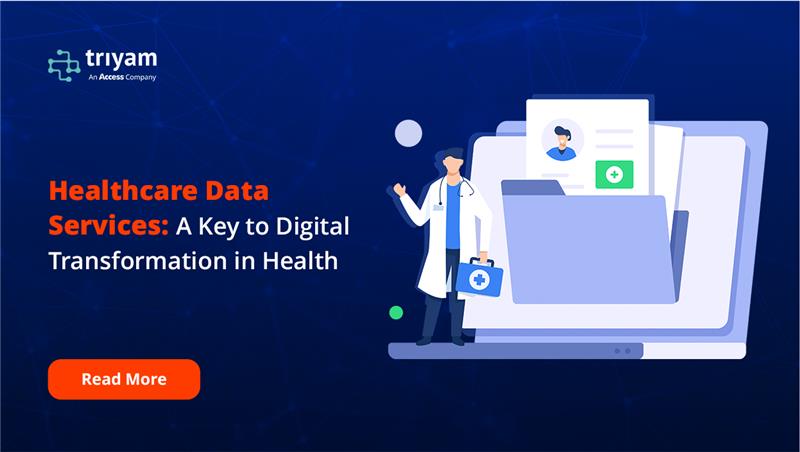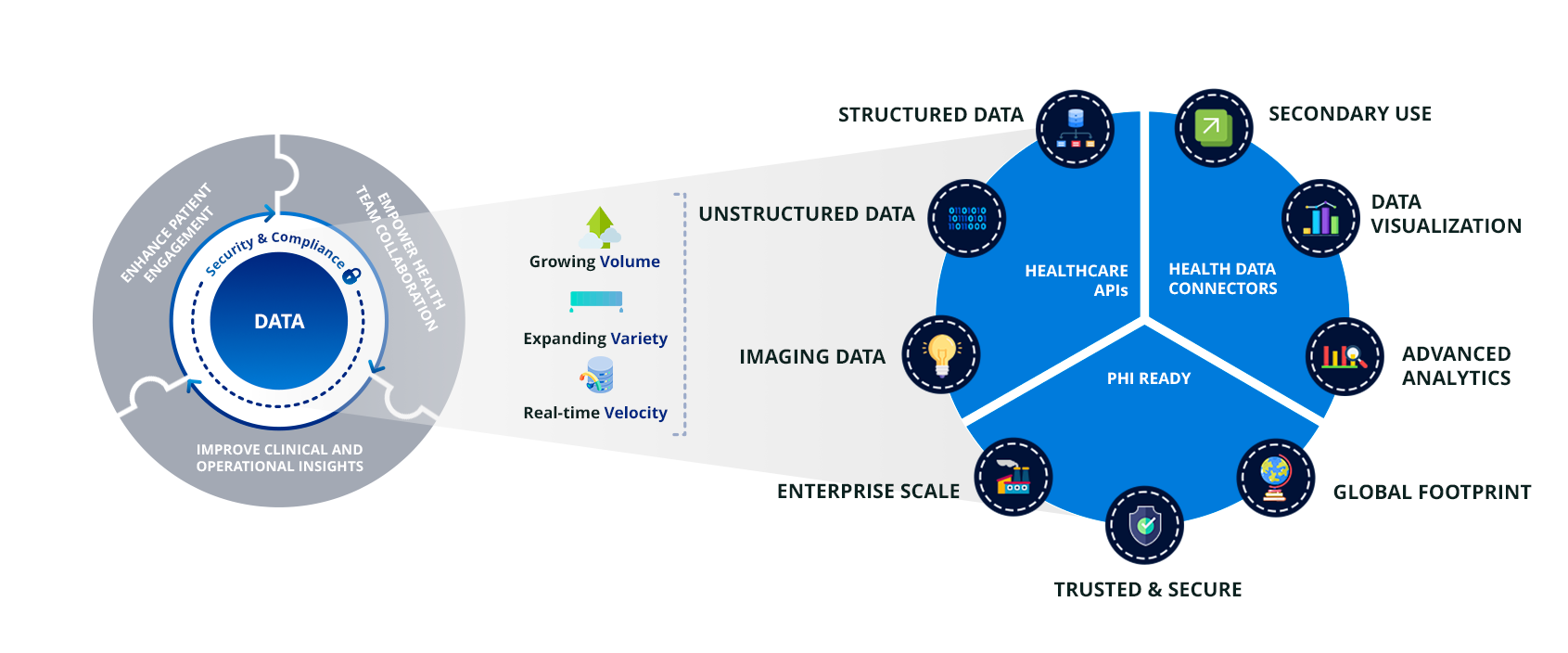
The healthcare industry is undergoing a significant digital shift, fueled by the need to enhance patient care, optimize operations, and meet regulatory requirements. Central to this transformation are Healthcare Data Services, which play a crucial role in building a more intelligent, connected, and efficient healthcare system
Health data refers to information related to health conditions, quality of life, causes of death, and reproductive outcomes for individuals or populations. It encompasses clinical metrics, along with behavioral, environmental, and socioeconomic factors that impact overall health and well-being.
There are 2 types of health data:
Structured data refers to information that is systematically arranged in predefined fields, such as patient demographics, vital signs, diagnoses, medications, and lab results.
Unstructured data on the other hand, consists of free-text clinical notes, medical images (like X-rays and MRIs), and patient comments. This type of data lacks a defined format, making it more challenging to analyze systematically.
Examples of Structured Healthcare Data:
-
- Patient demographics: Name, date of birth, address, gender
- Medical history: Past illnesses, surgeries, allergies
- Vital signs: Blood pressure, heart rate, temperature
- Laboratory test results: Blood chemistry, blood cell counts, etc
- Diagnoses: ICD-10 codes for medical conditions
- Medications: Prescription drugs, dosage, frequency
Examples of Unstructured Healthcare Data:
-
- Clinical notes include a doctor’s progress notes, discharge summaries, and consultation reports.
- Medical images: X-rays, CT scans, MRIs, ultrasounds
- Pathology reports: Detailed analysis of tissue samples
- Patient feedback: Comments, reviews, survey responses
- Audio recordings: Speech therapy sessions
- Emails/correspondence between patient and provider

What Are Health Data Services?
Health data services are technologies that assist organizations in gathering, storing, and analyzing healthcare information. Health data services can help organizations:
-
- Streamline health workloads
- Unify healthcare data in the cloud
- Discover new insights from health data
- Improve healthcare
- Enable new research projects.
Azure Health Data Services is a cloud-based platform designed to help you gather, store, and analyze health data from various sources and formats. It supports healthcare standards like FHIR® and DICOM®, while also converting data from legacy or proprietary formats into FHIR for better interoperability.
Azure Health Data Services enables you to:
-
- Unify health data from various systems, devices, and formats in one centralized location.
- Uncover valuable insights from health data using machine learning, analytics, and AI tools.
- Leverage a secure cloud platform that safeguards your health data and complies with privacy and regulatory standards.
Features of Healthcare Data Services:
-
- Rapid deployment of managed, enterprise-level FHIR and DICOM services.
- Solutions for merging diverse health data sets and standardizing data in the cloud.
- Integrations with Azure Synapse Analytics, Azure Machine Learning, and Power BI to derive insights from real-world data.
- Designed for protected health information (PHI), meeting all regional compliance requirements including HIPAA, GDPR (General Data Protection Regulation), and CCPA (California Consumer Privacy Act).
Why Healthcare Data Services Are Essential for Modern Health Systems?
Healthcare data services are crucial for modern health systems as they consolidate patient information, enabling providers to make more informed decisions and analyze trends for improved patient care to pinpoint areas for improvement, optimize resource allocation, and enhance patient outcomes while maintaining data security and privacy compliance, serving as the cornerstone of evidence-based medicine. and efficient operations within a healthcare system
Key benefits of healthcare data services:
-
- Improved patient care: Access to comprehensive patient data allows for more accurate diagnoses, personalized treatment plans, and coordinated care across different providers, leading to better overall patient outcomes.
- Cost reduction: Data analysis can highlight inefficiencies and waste, improving resource use and cost savings in healthcare organizations.
- Patient involvement: EHRs give patients access to their medical records, encouraging active participation in healthcare decisions.
- Improved data security: Strong data management systems with advanced security measures safeguard sensitive patient information from breaches.
- Operational optimization: Analyzing data trends helps healthcare organizations streamline scheduling, staffing, and resource use.
- Research and innovation: Large datasets can drive research, discover new treatments, and expand medical knowledge.
- Quality improvement: By monitoring patient outcomes and identifying areas for improvement, healthcare organizations can continuously enhance the quality of care provided.
- Adhering to strict privacy regulations such as HIPAA, healthcare data services ensure responsible management of patient data to maintain compliance.
What are The 4 PS of Healthcare Data?
The four Ps of healthcare data are
-
- Predictive
- Preventive
- Personalized
- Participative
These four Ps form the basis of a clinical medicine model focused on enhancing healthcare outcomes.
They play a vital role in addressing the root causes of disease and fostering overall health. Advancements in technology and interdisciplinary collaboration are crucial for gathering and analyzing health data, paving the way for more accurate and personalized treatments.
What are The Four Types of Data Analytics in Healthcare?
The four types of data analytics in healthcare are:
1. Descriptive analytics
Analyzes historical data to understand past events. For instance, a hospital could utilize descriptive analytics to determine the most frequent causes of patient admissions.
2. Diagnostic analytics
Uses historical data to identify the root causes behind a particular outcome. For example, diagnostic analytics can help determine the reasons behind a company’s decline in sales during a previous quarter.
3. Predictive analytics
Utilizes past and present data to forecast future trends or results. For instance, predictive analytics can assist healthcare providers in anticipating disease outbreaks and patient admissions.
4. Prescriptive analytics
Employs data, mathematical models, and business rules to recommend optimal actions. Prescriptive analytics leverages insights from descriptive, diagnostic, and predictive analytics to guide stakeholders in making decisions that enhance performance.
What Are Information Services in Healthcare?
Information services in healthcare include:
-
- Practice management systems Used to automate administrative tasks like scheduling patients and billing medical services
- Patient portals: Online platforms enabling patients to access their health records, including medications, treatment history, and upcoming appointments.
- Remote patient monitoring (RPM): A telehealth approach that utilizes digital devices to track patients’ health outside conventional healthcare environments.
- Clinical decision support (CDS): Delivers real-time information to aid healthcare providers in making informed care decisions.
- Health information managers: Responsible for compiling, organizing, maintaining, and safeguarding confidential medical records.
Other information services in healthcare include:
-
- Developing health information systems that adhere to legal, medical, and ethical guidelines.
- Entering and maintaining information in electronic medical records (EMR)
- Monitoring information in the EMR for accuracy
A good healthcare service provider should offer the following services:
-
- Enhance patient care and research outcomes with analytics and insights—Utilize built-in global open standards like FHIR® and DICOM® to ensure data privacy, de-identify data for secondary use, and leverage AI tools for insights.
- Streamline healthcare operations—Centralize healthcare data in the cloud for easier exchange across the care continuum. Use FHIR and DICOM services to standardize clinical, imaging, device, and unstructured data.
- Decentralize clinical trials with remote monitoring—Shift from reactive to proactive care for improved patient outcomes. Facilitate remote monitoring, accelerate clinical trials, and enable virtual care access for patients.
- Process imaging data efficiently—Simplify radiology and digital pathology workflows with DICOM cast technology. Manage, store, and exchange DICOM files in the cloud, and query metadata to reduce diagnosis time.. Process medical imaging data into research cohorts quickly and at scale.
The Future of Healthcare Data Services
As healthcare’s digital transformation progresses, the importance of Healthcare Data Services will grow. The integration of AI, big data analytics, and machine learning will boost predictive capabilities and allow for more personalized, precision-based care. Moreover, developments in blockchain technology could provide more secure and transparent methods for managing health data across various systems.
Healthcare Data Services play a crucial role in advancing the digital transformation of the healthcare sector. By enabling better patient care, operational efficiency, regulatory compliance, and innovation, these services are helping healthcare organizations transition into a more data-driven, patient-centered future. As the healthcare industry evolves, organizations that adopt Healthcare Data Services will be better equipped to provide high-quality care and succeed in a more competitive environment.
Triyam has been providing excellent healthcare data services since 2012. Safeguard data privacy while adhering to compliance regulations, de-identify data for secondary purposes, and leverage analytics and AI tools to generate valuable insights.
Plan ahead with clear, transparent pricing—no upfront costs or hidden fees, only pay for what you use. Our Health Data Services pricing is determined by structured storage usage, provisioned throughput and service runtime.
💡 Click here to know about a few other healthcare data terminologies:
